Integrated 3D Geological Modeling to Gain Insight in the Effects of Hydrothermal Alteration on Post-Ore Deformation Style and Strain Localization in the Flin Flon Volcanogenic Massive Sulfide Ore System
Abstract
1. Introduction
2. Geological Setting
3. Materials and Methods
- Multivariate interpretation of alteration indices computed from drill core and outcrop major oxide analyses to characterize the type and intensity of hydrothermal alteration.
- Joint registration and visualization of the alteration indices with 3D models of sulfide ore lenses, lithostratigraphic horizons and shear zones, as well as their 2D visualization on vertical cross sections, to facilitate interpretation of alterations and ore zones in their structural geologic context.
- Spatial interpolation of the alteration indices on a 3D curvilinear-faulted grid to further enhance insight into the spatial association between geological structure and the hydrothermal alteration zones and to better assess their structural continuity.
- A groundmass and phenocryst mineralogy in coherent volcanic rocks that is in agreement with the rock class assigned to the sample.
- Lack of visible texture indicative of hydrothermal alteration.
- No anomalously high contents of sericite, chlorite, biotite, quartz.
- Agreement between the classification from the Barth-Niggli normative mineral estimation and the rock class label assigned to the sample (i.e., basalt, andesite for mafic volcanic rocks and rhyolite, dacite for felsic volcanic rocks).
4. Results
4.1. Hydrothermal Alteration Trends (Proxies for Type/Intensity)
- Trend 1: This trend is typical of weak sericitization at the margins of the hydrothermal system [4]. This trend is not present in the samples of mafic volcanic rocks and is ambiguous for some of the felsic volcanic rock samples. This trend is poorly represented in the Flin Flon lithogeochemical data and is likely due to the truncation of the laterally extensive conformable hydrothermal alteration zone at deeper levels in the footwall by D3 thrust faulting.
- Trend 2: This trend is typical of intense sericite-chlorite + pyrite alteration in mafic and felsic volcanic rocks in the proximal footwall of the hydrothermal alteration system [4]. This trend is evident in many samples of felsic volcanic rocks (coherent and brecciated rhyolite lithofacies) as they represent the dominant host rocks of the VMS deposits.
- Trend 3: This trend is typical of chlorite-dominated proximal footwall alterations of felsic or mafic volcanic rocks and commonly associated with discordant hydrothermal alteration feeder zones [4]. This trend is evident in samples of mafic and felsic volcanic rocks and consistent with the chlorite-dominant mineral assemblages in the D4 shear zones in the proximal footwall of the VMS ore zones.
4.2. 3D Structural Setting of the Flin Flon VMS Deposit
4.3. Spatial Association between Hydrothermal Alteration, Ore and Shear Zones
5. Discussion
6. Conclusions
Supplementary Materials
Acknowledgments
Author Contributions
Conflicts of Interest
References
- Franklin, J.M.; Gibson, H.L.; Jonasson, I.R.; Galley, A.G. Volcanic-associated massive sulfide deposits. Econ. Geol. 2005, 100, 523–560. [Google Scholar]
- Franklin, J.M.; Sangster, D.F.; Lydon, J.W. Volcanic-associated massive sulfide deposits. Econ. Geol. 1981, 75, 485–627. [Google Scholar]
- Lydon, J.W. Volcanogenic massive sulfide deposits, Part 2: Genetic models. Geosci. Can. 1988, 3, 155–182. [Google Scholar]
- Large, R.R.; Gemmell, J.B.; Paulick, H. The alteration box plot: A simple approach to understand the relationship between alteration mineralogy and lithogeochemistry associated with volcanic-hosted massive sulfide deposits. Econ. Geol. 2001, 96, 957–971. [Google Scholar] [CrossRef]
- Ishikawa, Y.; Sawaguchi, T.; Iwaya, S.; Horiuchi, M. Delineation of prospecting targets for Kuroko deposits based on modes of volcanism of underlying dacite and alteration halos. Min. Geol. 1976, 26, 105–117. [Google Scholar] [CrossRef]
- Saeki, Y.; Date, J. Computer applications to alteration data of the footwall dacite lava at the Ezuri Kuroko deposits. Min. Geol. 1980, 30, 241–250. [Google Scholar] [CrossRef]
- Lentz, D.R. Petrology, geochemistry and oxygen isotope interpretation of felsic volcanic and related rocks hosting the Brunswick 6 and 12 massive sulfide deposits (Brunswick belt) Bathurst mining camp, New Brunswick, Canada. Econ. Geol. 1999, 94, 57–86. [Google Scholar] [CrossRef]
- Brauhart, C.W.; Huston, D.L.; Andrew, A.S. Oxygen isotope mapping in the Panorama VMS district, Pilbara Craton, Western Australia: Applications to estimating temperatures of alteration and to exploration. Miner. Depos. 2000, 35, 727–740. [Google Scholar] [CrossRef]
- Dubé, B.; Mercier-Langevin, P.M.; Hannington, M.; Lafrance, B.; Gosselin, G.; Gosselin, P. The LaRonde Penna world-class Au-rich volcanogenic massive sulfide deposit, Abitibi Quebéc: Mineralogy and geochemistry of alteration and implications for genesis and exploration. Econ. Geol. 2007, 102, 633–666. [Google Scholar] [CrossRef]
- Van Staal, C.R.; Williams, P. Structure, origin and concentration of the Brunswick 12 and 6 orebodies. Econ. Geol. 1984, 79, 1669–1692. [Google Scholar] [CrossRef]
- Bleeker, W.; Parrish, R.R. Stratigraphy and U-Pb zircon geochronology of Kidd Creek: Implications for the formation of giant volcanogenic massive sulfide deposits and the tectonic history of the Abitibi greenstone belt. Can. J. Earth Sci. 1996, 1213–1231. [Google Scholar] [CrossRef]
- Lentz, D.R.; van Staal, C.R. Predeformational origin of massive sulfide mineralization and associated footwall alteration at the Brunswick 12 Pb-Zn-Cu deposit, Bathurst, New Brunswick: Evidence from the porphyry dike. Econ. Geol. 1995, 90, 453–463. [Google Scholar] [CrossRef]
- Castroviejo, R.; Quesada, C.; Soler, M. Post-depositional tectonic modification of VMS deposits in Iberia and its economic significance. Miner. Depos. 2011, 46, 615–637. [Google Scholar] [CrossRef]
- Franklin, J.M. Lithogeochemical and mineralogical methods for base metal and gold exploration. In Proceedings of Exploration 97: Fourth Decennial International Conference on Mineral Exploration; Gubins, A.G., Ed.; Prospectors and Developers Association of Canada: Toronto, ON, Canada, 1997; pp. 191–208. [Google Scholar]
- Tessier, A.C.; O’Donnell, J.J. Callinan/777 Deposit. Compilation and Target Generation Project. Unpublished Report. 2001. [Google Scholar]
- Lafrance, B.; Gibson, H.L.; Pehrsson, S.; Schetselaar, E.; DeWolfe, Y.M.; Lewis, D. Structural reconstruction of the Flin Flon volcanogenic massive sulfide mining district, Saskatchewan and Manitoba, Canada. Econ. Geol. 2016, 111, 849–875. [Google Scholar] [CrossRef]
- Schetselaar, E.; Pehrsson, S.; Devine, C.; Lafrance, B.; White, D.; Malinoswki, M. 3-D geological modelling in the Flin Flon mining district, Trans-Hudson Orogen, Canada: Evidence for polyphase imbrication of the Flin Flon-777-Callinan volcanogenic massive sulfide ore system. Econ. Geol. 2016, 111, 877–901. [Google Scholar] [CrossRef]
- Simard, R.-L.; MacLachlan, K.; Gibson, H.L.; DeWolfe, Y.M.; Devine, C.; Kremer, P.D.; Lafrance, B.; Ames, D.E.; Syme, E.C.; Bailes, A.H.; et al. Geology of the Flin Flon Area, Manitoba and Saskatchewan (Part of NTS 63K12, 13). Manitoba Innovation, Energy and Mines, Manitoba Geological Survey, Geoscientific Map MAP2010-1 and Saskatchewan Ministry of Energy and Resources, Geoscience Map 2010-2, 1 Colour Map, Scale 1:10000. Available online: http://publications.gov.sk.ca/documents/310/37248-GM2010-2_Flin_Flon.pdf (accessed on 20 December 2017).
- White, D.J.; Malinowski, M.; Devine, C.; Gilmore, K.; Schetselaar, E.; Pehrsson, S. Drill targeting with 3-D seismics for volcanogenic massive sulfide exploration in the Flin Flon mining camp. Econ. Geol. 2016, 111, 903–912. [Google Scholar] [CrossRef]
- Schetselaar, E.; Currie, M.; Pehrsson, S.; Devine, C.; Mwenifumbo, J. 3D Drillhole and Geologic Map Database of the Flin Flon Mining District, Manitoba and Saskatchewan. Geol. Surv. Can. 2011, 33. [Google Scholar] [CrossRef]
- Corrigan, D.; Pehrsson, S.; Wodicka, N.; de Kemp, E. The Paleoproterozoic Trans-Hudson Orogen: A prototype of modern accretionary processes. In Ancient Orogens and Modern Analogues; Murphy, J.B., Keppie, J.D., Hynes, A.J., Eds.; Geological Society, London, Special Publications: London, UK, 2009; Volume 327, pp. 457–479. [Google Scholar]
- Stern, R.A.; Syme, E.C.; Lucas, S.B. Geochemistry of 1.9 Ga MORB- and OIB-lie basalts from the Amisk collage, Flin Flon belt, Canada: Evidence for an intra-oceanic origin. Geochim. Cosmochim. Acta 1995, 59, 3131–3154. [Google Scholar] [CrossRef]
- Syme, E.C.; Lucas, S.B.; Bailes, A.H.; Stern, R.A. Contrasting arc and MORB-like assemblages in the Paleoproterozoic Flin Flon belt, Manitoba, and the role of intra-arc extension in localizing volcanic-hosted massive sulfide deposits. Can. J. Earth Sci. 1999, 36, 1767–1788. [Google Scholar] [CrossRef]
- Syme, E.C.; Bailes, A.H. Stratigraphic and tectonic setting of Early Proterozoic volcanogenic massive sulfide deposits, Flin Flon, Manitoba. Econ. Geol. 1993, 88, 566–589. [Google Scholar] [CrossRef]
- Bamburak, J.D. Metallic Mines and Mineral Deposits of Manitoba; Open File Report OF90-2; Manitoba Energy and Mines: Winnipeg, MB, Canada, 1990; p. 105.
- Thomas, D.J. New perspectives on the Amisk Group and regional metallogeny, Douglas Lake-Phantom Lake area, northern Saskatchewan. In Summary of Investigations 1990, Saskatchewan Geological Survey; Miscellaneous Report 90-4; Saskatchewan Energy and Mines: Saskatoon, SK, Canada, 1990; pp. 13–20. [Google Scholar]
- Jonasson, I.R.; Ames, D.E.; Galley, A.G. Sulfide Ore Geochemistry Database for Volcanogenic Massive Sulfide Deposits of the Paleoproterozoic Flin Flon belt. Geol. Surv. Can. 2009. [Google Scholar] [CrossRef]
- Devine, C.A.; Gibson, H.L.; Bailes, A.H.; MacLachlan, K.; Gilmore, K.; Galley, A.G. Stratigraphy of VMS-Hosting Volcanic and Volcaniclastic Rocks of the Flin Flon Formation, Flin Flin-Creighton Area, Saskatchewan and Manitoba. Available online: http://publications.gov.sk.ca/documents/310/88725-devine.pdf (accessed on 20 December 2017).
- Gibson, H.L.; Lafrance, B.; DeWolfe, M.; Devine, C.; Gilmore, K.; Pehrsson, S. Volcanic Reconstruction and Post Depositional Modification of a Cauldron Subsidence Structure within the Flin Flon VMS District. In Prospectors and Development Association of Canada (PDAC) Technical Session Presentation: Flin Flon: New Developments in an Old Camp; Prospectors and Development Association of Canada (PDAC): Toronto, ON, Canada, 2009. [Google Scholar]
- DeWolfe, Y.M.; Gibson, H.L.; Lafrance, B.; Bailes, A.H. Volcanic reconstruction of Paleoproterozoic arc volcanoes: The Hidden and Louis formations, Flin Flon, Manitoba, Canada. Can. J. Earth Sci. 2009, 46, 481–508. [Google Scholar] [CrossRef]
- Ames, D.E.; Galley, A.G.; Taylor, B.T.; Kjarsgaard, I.M.; Tardif, N. Hanging wall vectoring for buried VMS deposits, Paleoproterozoic Flin Flon mining camp, Manitoba, Canada. Econ. Geol. 2016, 111, 963–1000. [Google Scholar] [CrossRef]
- Starr, P.G. Sub-Greenschist to Lower Amphibolite Facies Metamorphism of Basalts: Examples from Flin Flon, Manitoba and Rossland, Britisch Columbia. Ph.D. Thesis, University of Calgary, Calgary, AB, Canada, January 2017; p. 495. [Google Scholar]
- Galley, A.G.; Syme, E.C.; Bailes, A.H. Metallogeny of the Paleoproterozoic Flin Flon belt, Manitoba and Saskatchewan; Geological Association of Canada, Mineral Deposits Division: St. John’s, NL, Canada, 2007; Special Publication 5; pp. 533–552. [Google Scholar]
- Best, M.G. Igneous and Metamorphic Petrology, 2nd ed.; Wiley-Blackwell: Malden, MA, USA, 2003; p. 752. ISBN 1405105887. [Google Scholar]
- Kampmann, T.C.; Jansson, N.F.; Stephens, M.B.; Majka, J.; Lasskogen, J. Systematics of hydrothermal alteration at the Falun base metal sulfide deposit and implications for ore genesis and exploration, Bergslagen ore district, Fennoscandian Shield, Sweden. Econ. Geol. 2017, 112, 1111–1152. [Google Scholar] [CrossRef]
- Knuckey, M.J.; Comba, C.D.A.; Riverin, G. Structure, metal zoning and alteration at the Millenbach deposit, Noranda, Quebec. In Precambrian Sulfide Deposits; Hutchinson, R.W., Spence, C.D., Franklin, J.M., Eds.; Geological Association of Canada: St John’s, NL, Canada, 1982; Special Paper 25; pp. 256–295. [Google Scholar]
- Piché, M.; Jébrak, M. Normative minerals and alteration indices developed for mineral exploration. J. Geochem. Explor. 2004, 82, 59–77. [Google Scholar] [CrossRef]
- Banks, R. The Use of linear programming in the analysis of penological mixing problems. Contrib. Mineral. Petrol. 1979, 70, 237–244. [Google Scholar] [CrossRef]
- De Caritat, P.; Bloch, J.; Hutcheon, I. LPNORM: A linear programming normative analysis code. Comput. Geosci. 1994, 20, 313–347. [Google Scholar] [CrossRef]
- Paktunc, A.D. MODAN: An interactive computer program for estimating mineral quantities based on bulk composition. Comput. Geosci. 1998, 24, 425–431. [Google Scholar] [CrossRef]
- Herrmann, W.; Berry, R.F. MINSQ—A least squares spreadsheet method for calculating mineral proportions from whole rock element analysis. Geochem. Explor. Environ. Anal. 2002, 2, 361–368. [Google Scholar] [CrossRef]
- Posch, M.; Kurz, D. A2M—A program to compute all possible mineral modes from geochemical analyses. Comput. Geosci. 2007, 33, 563–572. [Google Scholar] [CrossRef]
- Grunsky, E.C. Recognition of alteration in volcanic rocks using statistical analysis of lithogeochemical data. J. Geochem. Explor. 1986, 25, 157–183. [Google Scholar] [CrossRef]
- Grunsky, E.C. Recognition of alteration and mineralization in volcanic terrains. In Proceedings of the International Volcanological Congress, Symposium: Volcanism, Hydrothermal Systems & Related Mineralization, Auckland, New Zealand, 1–9 February 1986; Volume 5, pp. 51–56. [Google Scholar]
- Harris, J.R.; Wilkinson, L.; Grunsky, E.C. Effective use and interpretation of lithogeochemical data in regional mineral exploration programs: Application of geographic information systems (GIS) technology. Ore Geol. Rev. 2000, 16, 107–143. [Google Scholar] [CrossRef]
- Hyslop, N.P.; White, W.H. Estimating precision using duplicate measurements. J. Air Waste Manag. Assoc. 2009, 59, 1032–1039. [Google Scholar] [CrossRef] [PubMed]
- Schetselaar, E. Mapping the 3D lithofacies architecture of a VMS ore system on a curvilinear-faulted grid: A case study from the Flin Flon mining camp, Canada. Ore Geol. Rev. 2013, 53, 261–275. [Google Scholar] [CrossRef]
- Mallet, J.L. Space-time mathematical framework for sedimentary geology. Math. Geol. 2004, 36, 1–32. [Google Scholar] [CrossRef]
- Jayr, S.; Gringarten, E.; Tertois, A.L.; Mallet, J.L.; Dulac, J.C. The need for a correct geological modelling support: The advent of the UVT-transform. First Break 2008, 26, 73–79. [Google Scholar]
- Chiles, J.P.; Delfiner, P. Geostatistics: Modelling Spatial Uncertainty; Wiley: Hoboken, NJ, USA, 1999; p. 695. ISBN 0471083151. [Google Scholar]
- Ames, D.E.; Tardif, N.; MacLachlan, K.; Gibson, H.L. Geology and Hydrothermal Alteration of the Hanging Wall Stratigraphy to the Flin Flon—777-Callinan Volcanogenic Massive Sulfide Horizon (NTS 63K12NW and 13 SW); Report of Activities; Manitoba Industry, Trade and Mines, Manitoba Geological Survey: Flin Flon Area, MB, Canada, 2002; pp. 20–34. [Google Scholar]
- Byron, J.; Schetselaar, E.; Gibson, H.; Pehrsson, S.; Lafrance, B.; Devine, C.; Ames, D. 3D Reconstruction of Base Metal Zoning in the Flin Flon—Callinan-777 Volcanogenic Massive Sulfide Deposits, Manitoba. Geol. Surv. Can. 2014. [Google Scholar] [CrossRef]
- Fedorowich, J.S.; Kerrich, R.; Stauffer, M. Geodynamic evolution and thermal history of the central Flin Flon Domain, Trans-Hudson Orogen: Constraints from structural development, Ar/Ar, and stable isotope geothermometry. Tectonics 1995, 14, 472–503. [Google Scholar] [CrossRef]
- Gale, D.F.G.; Lucas, S.B.; Dixon, J.M. Structural relations between the polydeformed Flin Flon arc assemblage and Missi Group sedimentary rocks, Flin Flon area, Manitoba and Saskatchewan. Can. J. Earth Sci. 1999, 36, 1901–1915. [Google Scholar] [CrossRef]
- Thomas, D.J. Highlights of investigations around the Flin Flon mine: reassessment of structural history. In Summary of Investigations 1992, Saskatchewan Geological Survey Saskatchewan Energy and Mines; Miscellaneous Report 92-4; Saskatchewan Energy and Mines: Saskatoon, SK, Canada, 1992; pp. 3–15. [Google Scholar]
- Rayner, N. New U-Pb zircon ages from the Flin Flon Targeted Geoscience Initiative Project 2006–2009: Flin Flon and Hook Lake blocks, Manitoba and Saskatchewan. Geol. Surv. Can. 2010, 4, 15. [Google Scholar] [CrossRef]

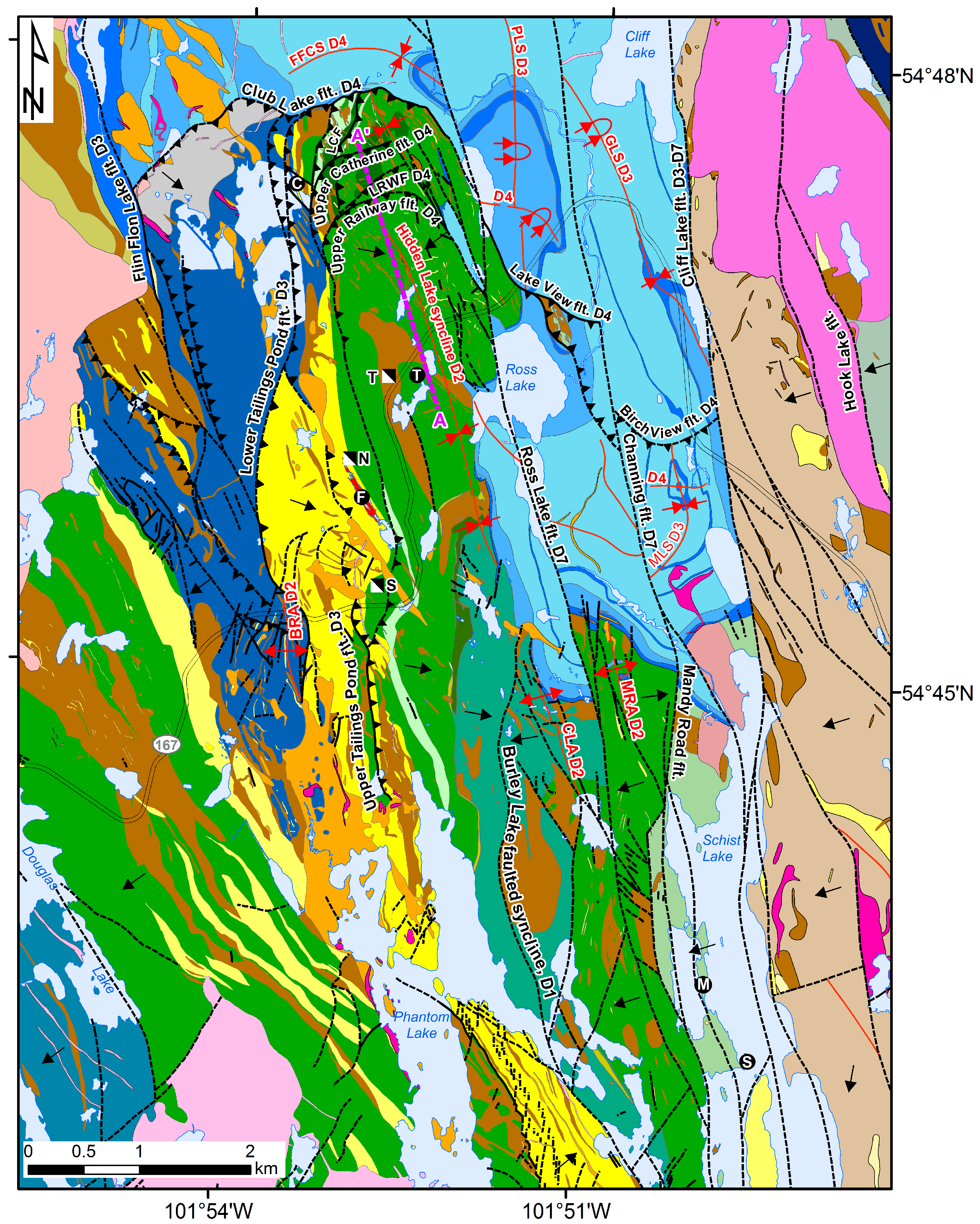
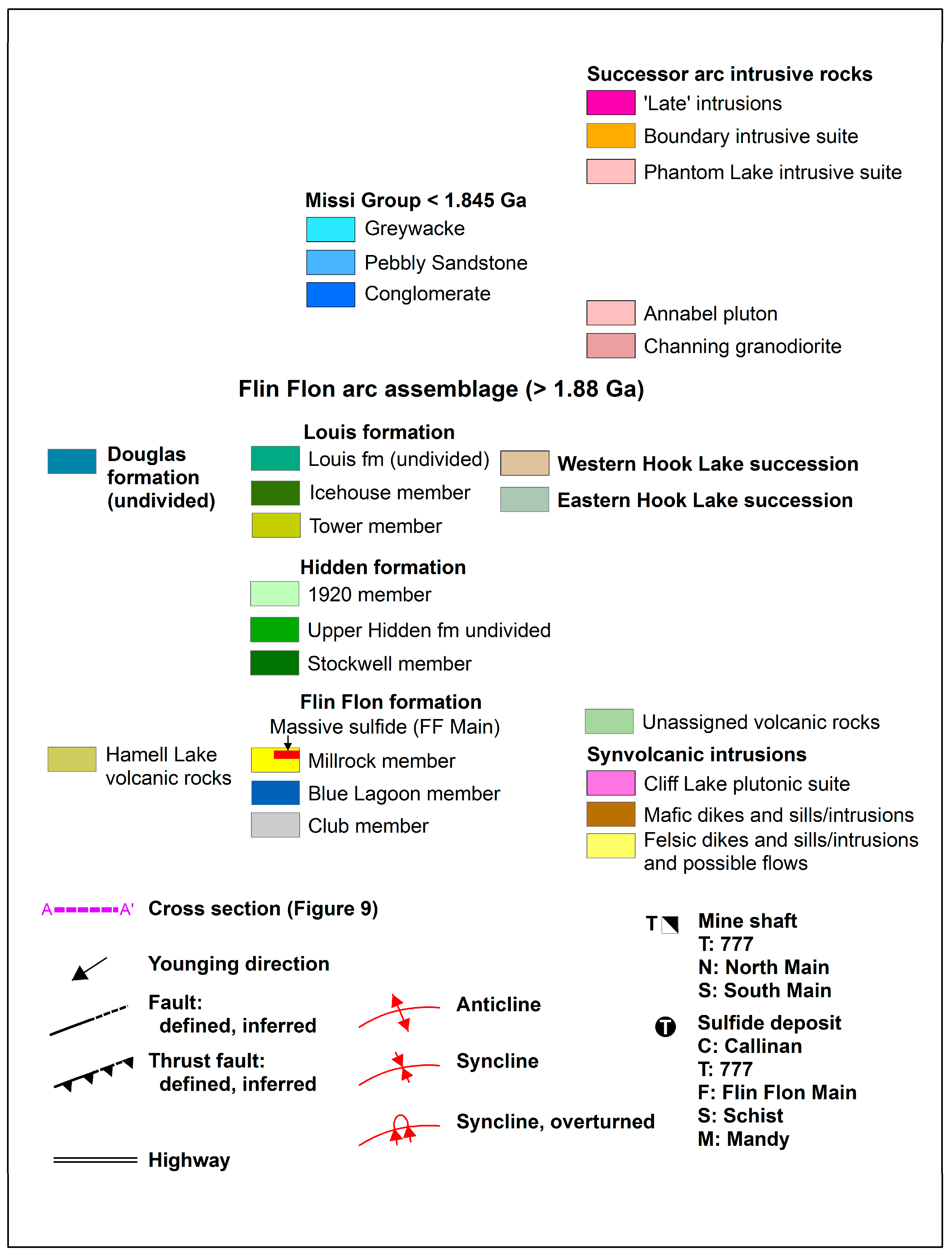
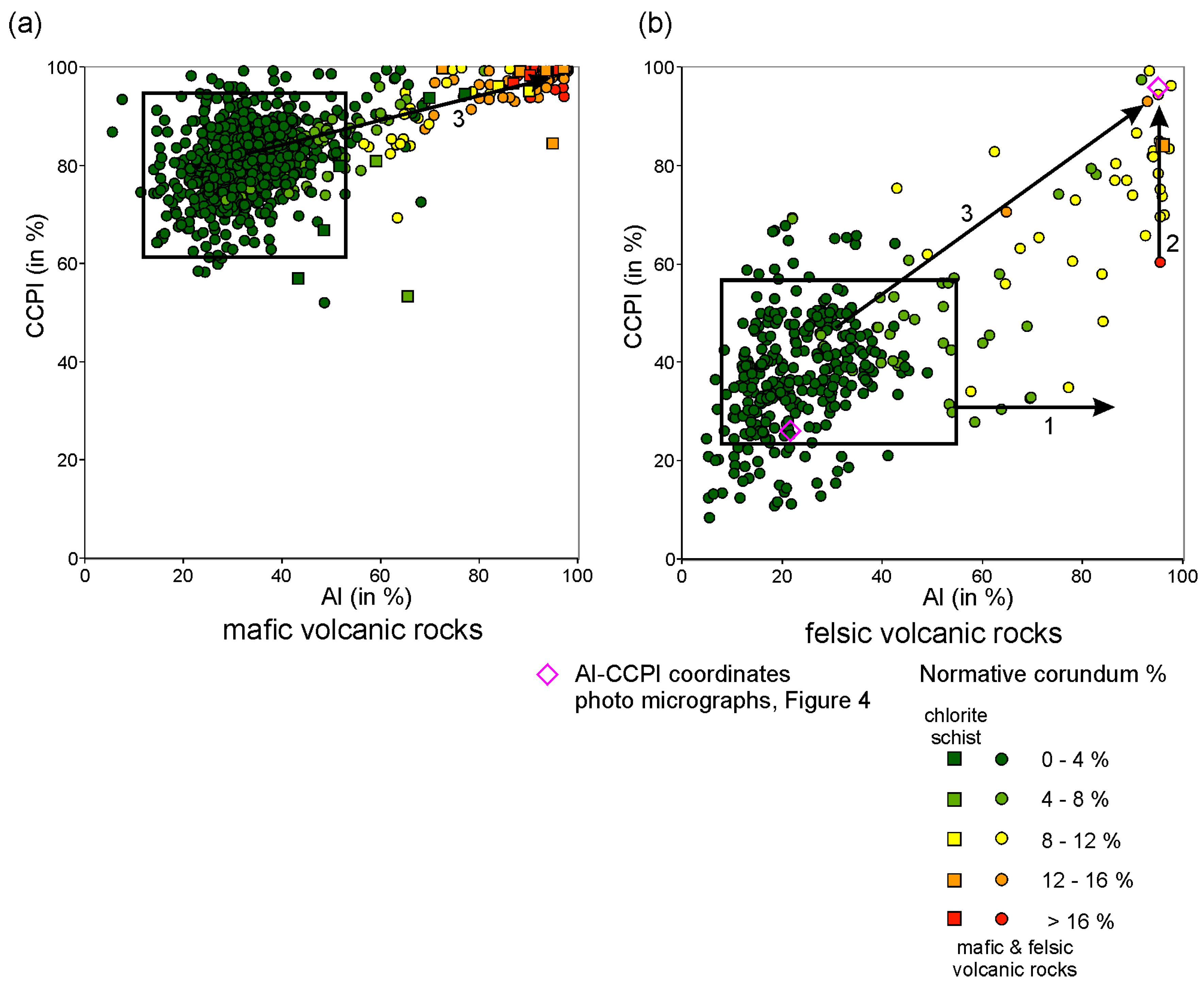
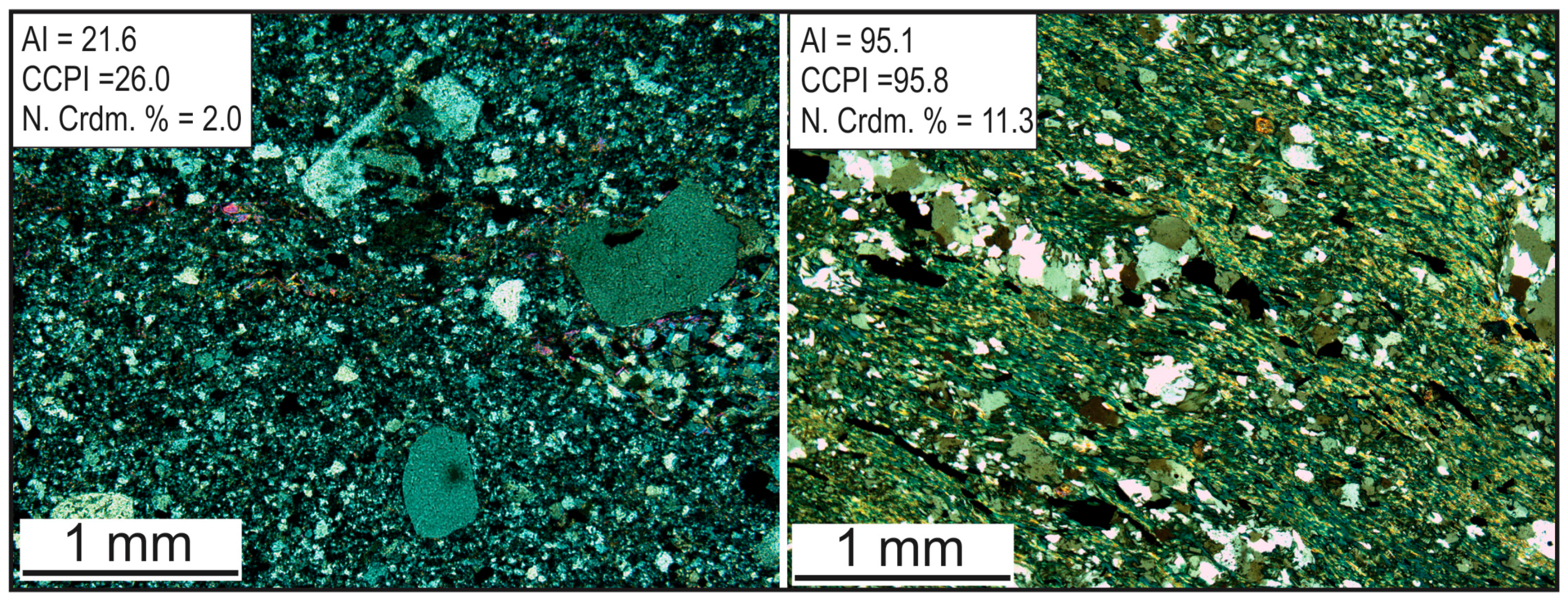
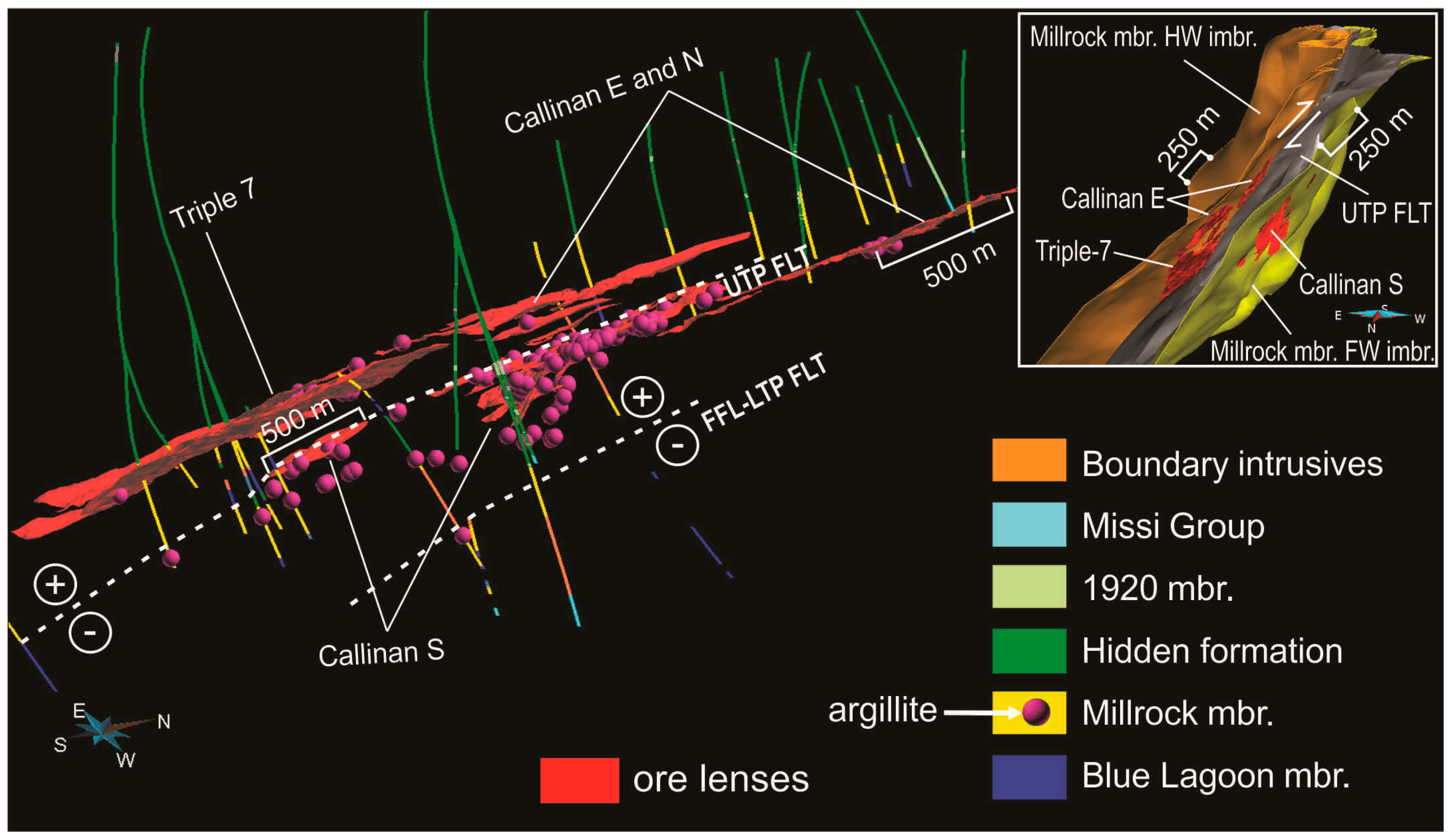
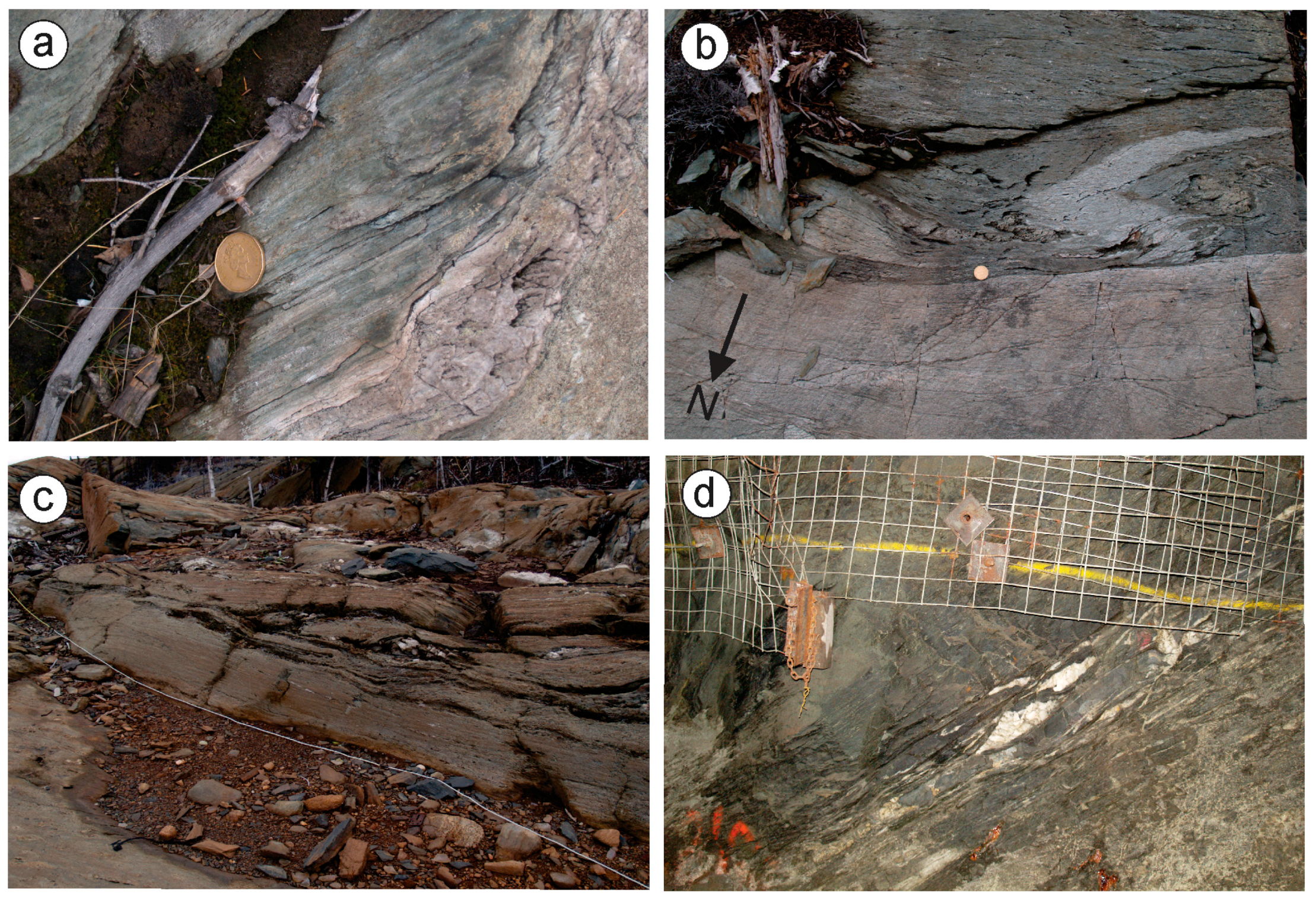
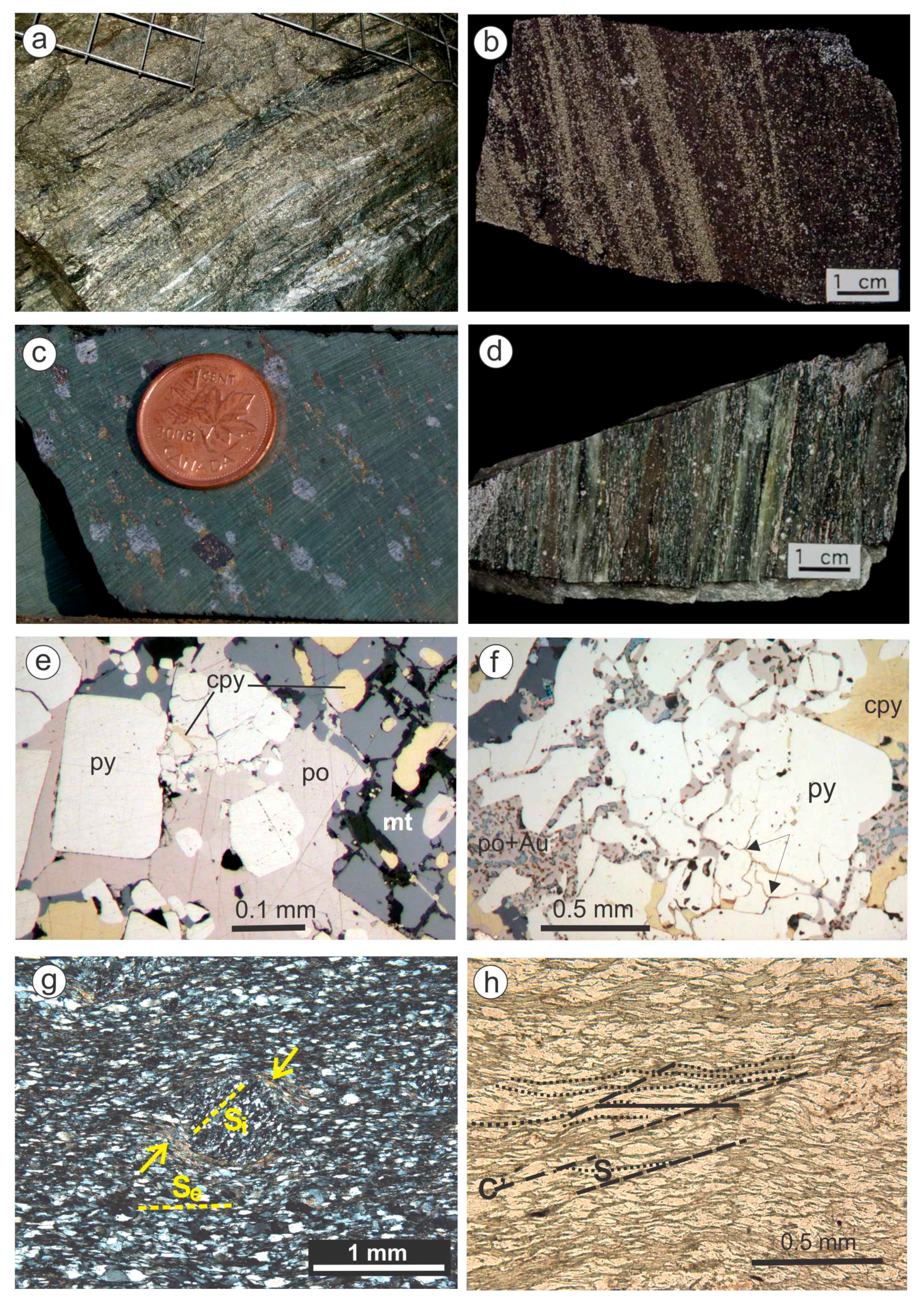
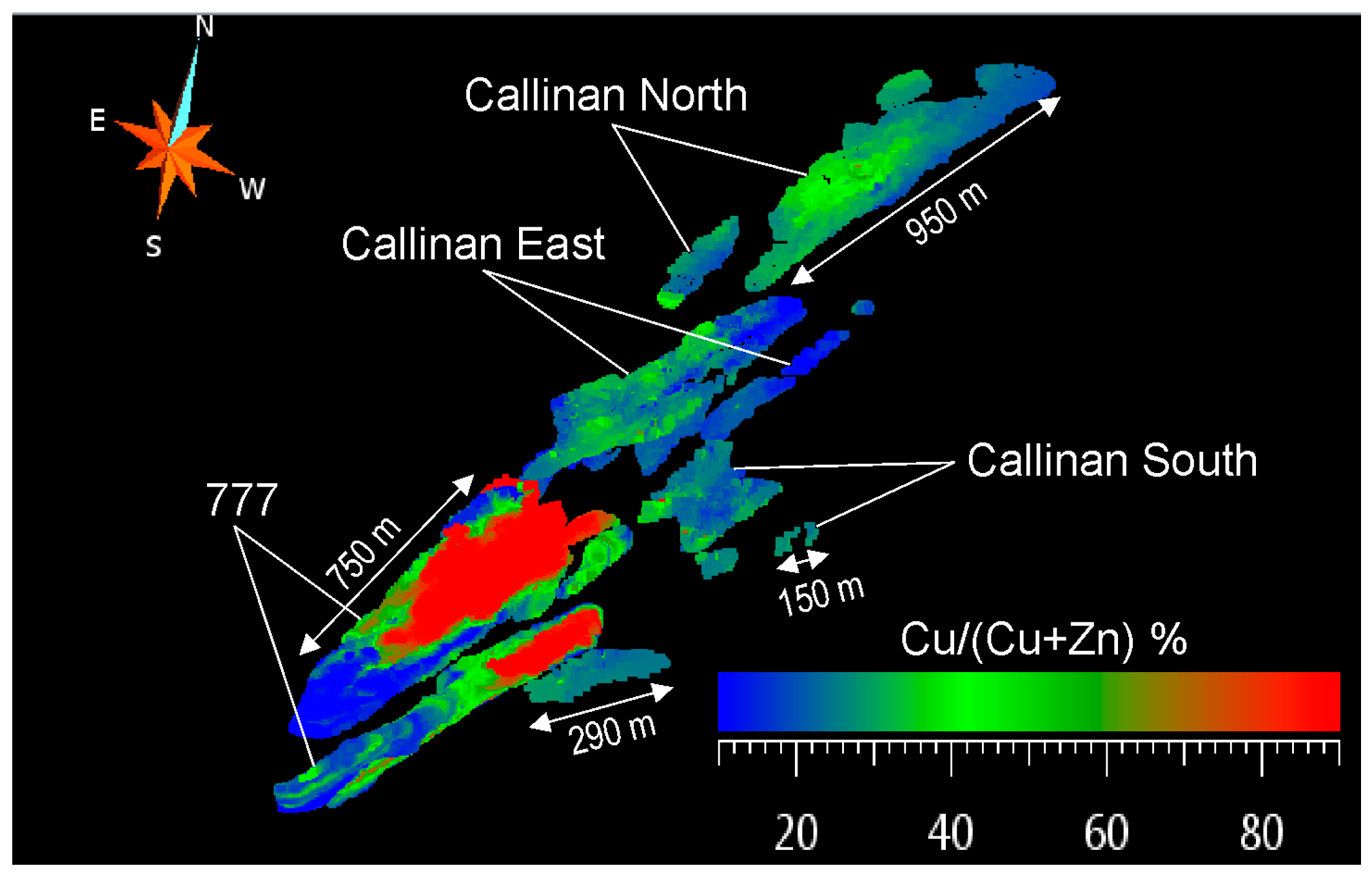
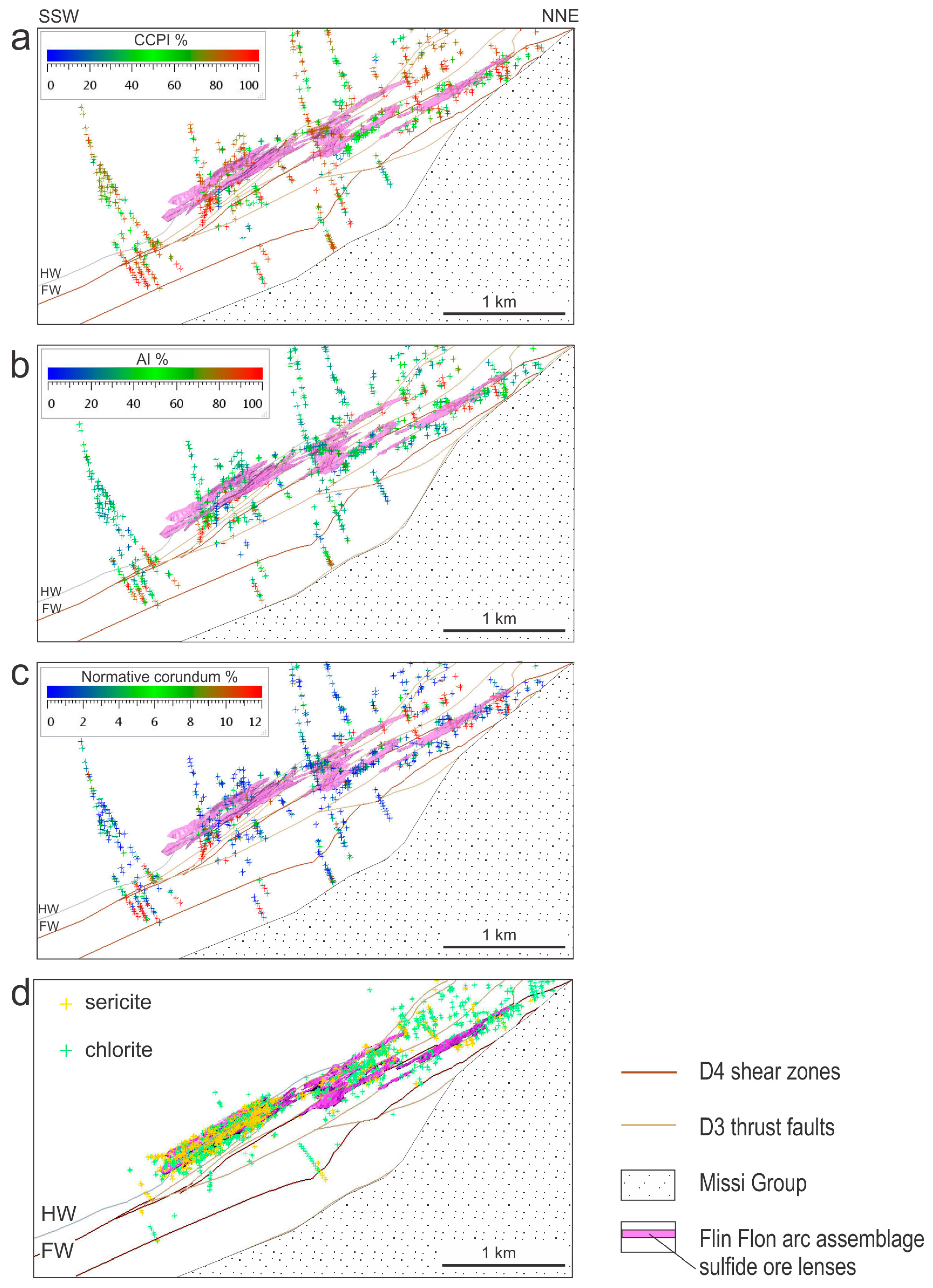
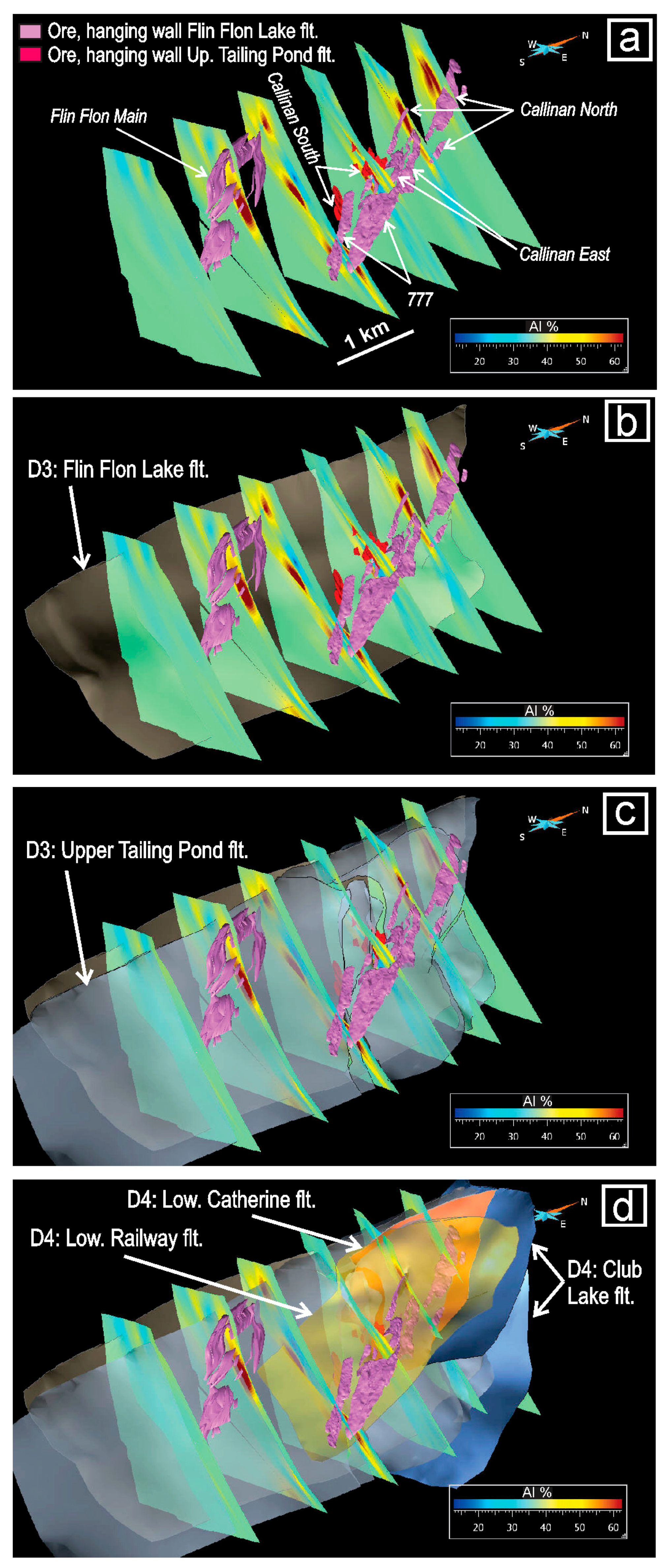

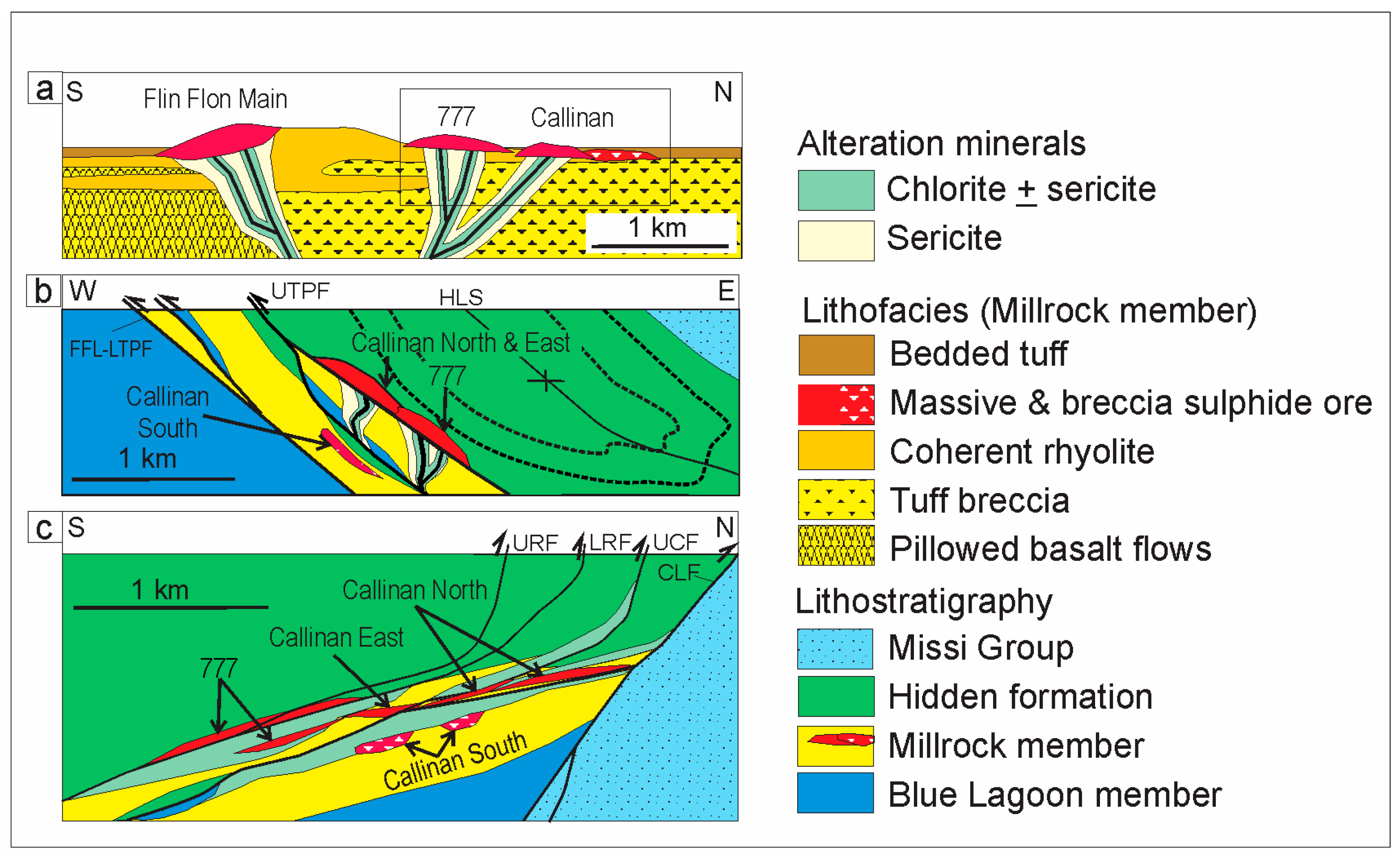
| Duplicate Error Analysis Alteration Indices | RMSE ICP-ICP | n | RMSE XRF-XRF | n | RMSE ICP-XRF | BIAS ICP-XRF | n |
|---|---|---|---|---|---|---|---|
| Total | |||||||
| AI% | 10.8% | 43 | 19.2% | 6 | 5.1% | 1.9% | 72 |
| CCPI% | 3.8% | 43 | 7.1% | 6 | 2.2% | −0.4% | 71 |
| Norm. Crn. % | 39.1% | 16 | 35.3% | 22.6% | 24 | ||
| Altered | |||||||
| AI % > 60 | 3.1% | 8 | 1.79% | 1.22% | 5 | ||
| CCPI % > 60 | 0.25% | 27 | 2.64 | 5 | 0.99% | −0.3% | 60 |
| Norm. Crn. % > 5 | 6.7% | 8 | 11.45% | 11.6% | 7 | ||
© 2017 by the authors. Licensee MDPI, Basel, Switzerland. This article is an open access article distributed under the terms and conditions of the Creative Commons Attribution (CC BY) license (http://creativecommons.org/licenses/by/4.0/).
Share and Cite
Schetselaar, E.; Ames, D.; Grunsky, E. Integrated 3D Geological Modeling to Gain Insight in the Effects of Hydrothermal Alteration on Post-Ore Deformation Style and Strain Localization in the Flin Flon Volcanogenic Massive Sulfide Ore System. Minerals 2018, 8, 3. https://doi.org/10.3390/min8010003
Schetselaar E, Ames D, Grunsky E. Integrated 3D Geological Modeling to Gain Insight in the Effects of Hydrothermal Alteration on Post-Ore Deformation Style and Strain Localization in the Flin Flon Volcanogenic Massive Sulfide Ore System. Minerals. 2018; 8(1):3. https://doi.org/10.3390/min8010003
Chicago/Turabian StyleSchetselaar, Ernst, Doreen Ames, and Eric Grunsky. 2018. "Integrated 3D Geological Modeling to Gain Insight in the Effects of Hydrothermal Alteration on Post-Ore Deformation Style and Strain Localization in the Flin Flon Volcanogenic Massive Sulfide Ore System" Minerals 8, no. 1: 3. https://doi.org/10.3390/min8010003
APA StyleSchetselaar, E., Ames, D., & Grunsky, E. (2018). Integrated 3D Geological Modeling to Gain Insight in the Effects of Hydrothermal Alteration on Post-Ore Deformation Style and Strain Localization in the Flin Flon Volcanogenic Massive Sulfide Ore System. Minerals, 8(1), 3. https://doi.org/10.3390/min8010003




